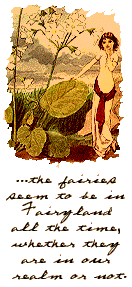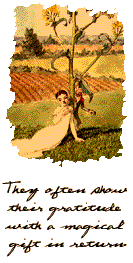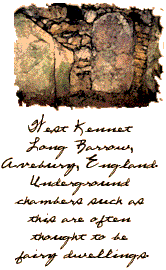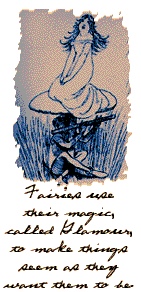|

|
Everyone has heard at least a bit about Fairyland. And
like almost everything else about The Good People, the
stories we are told are full of contradictions. The problem
seems to be that all the reports are from human witnesses
who sometimes see Fairyland through ordinary eyes and other
times through the eyes of magic.
The first thing that must be said about Fairyland is that
it is very hard to tell, from all the information that we
have, if it is another place, or whether it is right here
but invisible to most people most of the time.
We hear often of a person wandering in the night who
happens upon a group of fairies dancing (which they love to
do) or riding in the hunt, or in ceremonial procession. The
person follows them, and sees them all come to a hill which
opens up and admits them. Now, this hill is often well-known
to the witness as an ordinary mound of earth, and it can't
be made to open up except at the fairies' command. So we
must ask ourselves, is the place that opened up an entrance
to fairy-land, or was the person who saw it all actually "in
fairyland" from the moment he saw the fairies on the hill?
The enchanted place seems to exist in the same spot as the
real place. Is it a place, or a state of mind?
Consider, also, that the fairies seem to be in Fairyland
all the time, whether they are in our realm or not.
|
|


|

Fairies are well-known to live underground, most often under
hills, in what are called "fairy raths." The ancient hilltop
earthen-forts found all over the British Isles are commonly
referred to as "fairy-forts", and most reports of entrances
to Fairyland happen in such places. Less frequently, we hear
of an entrance that was simply a hole in the earth.
Perhaps the most famous place that has been reported as a
portal to Fairyland is Glastonbury Tor ("hill") in England,
a place that has been considered holy since long before
Christian times. St. Collen, a early Welsh saint who lived
in a hermitage on the hill, reported entering it and
confronting Gwynn ap Nudd himself, the king of the Welsh
fairies. In more recent centuries, a church dedicated to St.
Michael was built on the top of the hill, perhaps because it
was feared that the fairies were really servants of the
devil, and St. Michael was revered for his power to suppress
the demonic flames.
Lucky observers in many different places have told of
seeing a hill open up, with its top raised up on pillars and
light streaming out, usually on a special night of the year
such as All Hallows Eve (Hallowe'en) or May Eve. Others have
told of coming to an ancient ruin when the fairies were at
their revels within and seeing light stream out of it.
The question of light is important, because most visitors
to the fairies' underground homes have mentioned how they
were lit up within by neither sunlight nor torch nor
lantern, yet there was light, sometimes a dull glow,
sometimes light almost as brilliant as day. (Some sources
relate that the fairies grow crops under the earth,
particularly barley. But it is generally thought that they
are able to provide little of their own food, and so are
forced to "borrow" from mortals so very often. This is why
those who would befriend the Good People often leave them
gifts of food or milk. When they are not forced to steal,
but can obtain a willing loan, they often show their
gratitude with a magical
gift in return.) The source of fairy light remains
unknown.
|
|
|

Nowadays, when fairies are so very rare, most people would
be delighted to meet them. But in olden times, when they
were more plentiful and, it would seem, more powerful,
people were often quite afraid of them. These fears chiefly
centered around the dangers of offending them (see
"People and Fairies") and
around the possibility of being "lost"
in Fairyland. It was considered worthwhile to be able to
ward off fairies. Rue is a powerful anti-fairy herb. So are
St. John's wort and yarrow. Carrying a piece of iron
(especially a cross or a horseshoe), four leaf clovers,
walking sticks made of mountain ash or rowan wood, and
trinkets made of coral or amber were also said to be good
protection. Fairies are also repelled by the sound of church
bells, and it has been said that the decline of the fairy
population (in the British isles, at least) directly
parallels the increase in the number of churches across the
land.
|
|
|

It has often been reported that one can be "lost in
Fairyland" without going anywhere at all. Sometimes a person
is "with the fairies" but seemingly still in a place on the
Earth. If you set both feet in a fairy-ring, you may well
see the fairies dancing madly there, and suddenly hear their
music, often described as the sweetest ever heard. People
who experience this are often drawn irresistibly to joining
the dance. Meanwhile, anyone who might have been with them,
but outside the fairy-ring, thought their companion had
disappeared, and saw nothing of the fairies and heard
nothing of the music. The person who stepped into the ring
became quite as invisible as the fairies, and there is good
reason to believe he was then in Fairyland... even though he
had not left the fairy-ring.
|
|
|

Often, the person who has crossed over into Fairyland lives
in a different frame of time than we do here. The stories of
those who've wandered into the fairy-ring and joined the
dance sometimes tell of the vanished person being rescued
from the fairy-ring a year-and-a-day later, only to have the
rescued victim complain that he just wanted to finish the
dance and he'd only been dancing there a few minutes. More
mysterious yet are those travelers who've entered fairyland,
whether by accident or foolishness or by the lure of the
music or some other fairy trickery, and stayed at their
revels and feasts for what seemed to be a few days or weeks.
But when they returned to their own land, to their home
town, they saw not a single person they knew. Those who they
questioned had not ever heard the name of the traveler or
his family. Often the only person who'd ever heard of them
was the oldest person in the village, for the traveler was
one who was said to have disappeared with the fairies two or
three hundred years before!
|
|

|

The reason that human travelers in Fairyland are so often
confused is that the fairies use their magic, called
Glamour, to make things seem as they want them to be. And
this trickery would be completely impenetrable to us, we
would not know of it at all, were it not for those few who
have chanced to undo its magic and see the truth. This has
happened more than once when a human midwife was summoned in
the night to aid a woman in child-birth, only to find it was
a fairy-woman. The midwife is brought to a strange place and
sees within a grand and luxurious palace. The fairy
noblewoman and her husband wear fine and beautiful clothes
and are themselves as beautiful as the eye can bear. When
the baby is born, the midwife is instructed to rub it all
over with a special ointment. But if she happens to rub a
bit of it near her eye, suddenly that eye sees the scene
quite differently. The palace now appears as nothing but a
dank, dirty cave, the rich bed but a pallet of straw, the
rich clothing merely rags, the beautiful fairies now old and
drawn and wizened. The ointment has removed the "glamourous"
magic from her eye and what she sees is... the truth? Hard
to say, for people who have seen fairies without their
knowledge or consent have still reported them as beautiful
creatures. It is a mystery.
One point on which there seems little argument is that you
must not take food or drink in Fairyland, nor pick the
flowers, or you risk becoming a captive there. As noted
earlier, the visitor to Fairyland scarcely notices the
passage of time, and that delusion alone serves as an
effective prison.
|
|
|

There are also tales of people carried off to Fairyland.
Sometimes a beautiful young woman has been taken to become a
fairy bride. Sometimes a person is deliberately lured by the
music and dancing, for reasons we do not know. Rev Robert
Kirk, who wrote extensively about the fairies of Scotland in
"The Secret Commonwealth of Elves, Fauns and Fairies" (1692)
and revealed many things about them, was finally said to
have been carried off by them one night when he visited a
fairy fort. Perhaps they were angry with him, for they hate
to have their secrets told. He is said to have "appeared" to
his cousin a few days later and explained the method by
which he could be rescued, but when the moment came, the
poor man was too frightened to carry through, and Kirk was
never rescued. The human captured by the fairies is held by
bonds of enchantment, though they can sometimes be saved if
they have not eaten fairy food.
There are several known methods to rescue a fairy captive.
If someone with you disappears in a fairy ring, you had best
return to the spot exactly one year and one day later. Set
one foot (and one foot only) inside the ring. Then the
dancing fairies, and the person you seek to rescue, will be
visible to you. Grab the person with both arms and hold on
tight and pull them out of the ring with all your strength.
If a person has actually been taken by the fairies, the
rescue may be similar, but more difficult. You must learn
when the fairy procession will ride by, and rush out to grab
the victim. Then you must hold on tight until dawn, no
matter what terrors surround you, no matter what shapes or
wild beasts the person may seem (by fairy magic) to changed
into. It may help to put your own clothing around the victim
to protect her. Another method is to throw a bucket of pure
milk, with not a drop of water in it, over the victim as the
procession passes, though this may not work with all sorts
of fairies.
|

 Copyright © 1997 by
Paramount Pictures.
Copyright © 1997 by
Paramount Pictures.
|






